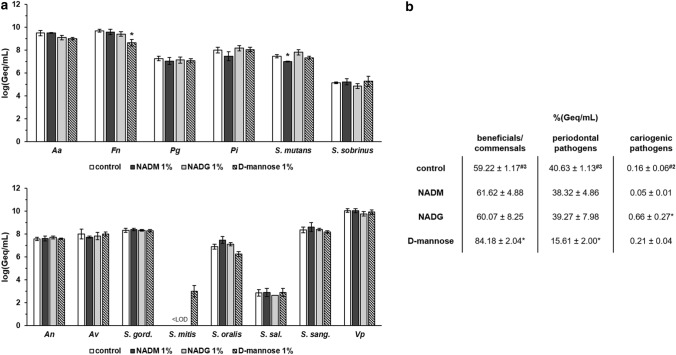Figure 2.
Comparison of the effects of repeated rinsing with NADM, NADG or d-(+)-mannose at ~ 0.05 M (1%(w/v)) on multi-species biofilm composition. (Panel a) Absolute abundances of pathogenic oral species (upper graph) and beneficial/commensal oral species (lower graph) are shown as mean ± SD (n = 3) logarithmic values of the genome equivalents per millilitre (log(Geq/mL)). (Panel b) Relative abundances of the different groups (beneficial/commensals, periodontal pathogens, cariogenic pathogens) of bacterial species are shown as mean ± SD (n = 3) percentage of the genome equivalents per millilitre (%(Geq/mL)). All substrates were dissolved in PBS at a concentration of ~ 0.05 M (1%(w/v)) (corresponding molar concentrations: 0.045 M (NADM and NADG) and 0.056 M (d-(+)-mannose)). Statistically significantly different values when compared to the control (PBS) are marked with ‘*’ (P < 0.05 ANOVA + Dunnett’s correction for simultaneous hypothesis testing), statistically significantly different values between two treatment conditions (NADM = condition 1, NADG = condition 2, d-(+)-mannose = condition 3), which were only considered to be relevant if each condition was also significantly different from the control conditon, are marked with ‘#’ (P < 0.05, ANOVA + Tukey’s correction for simultaneous hypothesis testing for comparisons between 3 substrates, unpaired two-tailed t-test for comparisons between 2 substrates). Aa: A. actinomycetemcomitans; Fn: F. nucleatum; Pg: P. gingivalis; Pi: P. intermedia; An: A. naeslundii; Av: A. viscosus; S. gord.: S. gordonii; S. sal.: S. salivarius; S. sang.: S. sanguinis; Vp: V. parvula; LOD: limit of detection (= 2.65 log(Geq/mL)); NADM: N-acetyl-d-mannosamine; NADG: N-acetyl-d-glucosamine.

